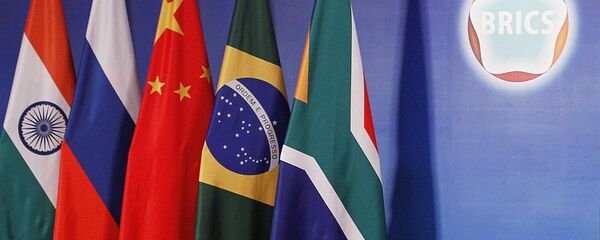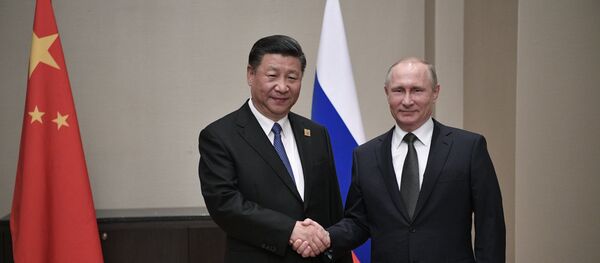MOSCOW (Sputnik) — Putin described Xi's visit to be this year's key event in the Russian-Chinese relations since the leaders are planning to discuss a number of issues on both bilateral and international agenda with topics ranging from energy and trade to strategic cooperation.
The rapidly developing Russian-Chinese relations are based on a substantive legal framework, a ramified organizational structure, and welcome active ties at all levels.
The People’s Republic of China (PRC) and the Soviet Union established diplomatic relations on October 2, 1949. The Soviet Union became the first foreign state to recognize China.
After the breakup of the Soviet Union, Chinese government recognized the Russian Federation on December 24, 1991 as a legal successor of the former Soviet Union’s international rights and obligations.
The Treaty of Good-Neighborliness, Friendship and Cooperation between Russia and China of July 16, 2001 outlines the main principles and aspects of bilateral cooperation.
Both sides officially identify current Russian-Chinese relations as all-round, equitable and trustful partnership and strategic cooperation.
The two states maintain intensive political dialogue. Putin and Xi meet at least five times a year.
In June 2016, the Russian president paid an official visit to China. During the visit, Putin met with Xi and other Chinese top officials. The sides focused on strengthening their economic cooperation, primarily, in the energy sphere. The issues of creation of a free trade zone between China and the Eurasian Economic Union, as well as China’s involvement in construction of high-speed Moscow-Kazan railway, were raised. After the talks, both sides signed a package of documents dealing with various cooperation aspects, including space exploration, energy, tourism and grain deliveries to China.
In 2016, Russian and Chinese heads of state also held bilateral meetings within the Shanghai Cooperation Organisation (SCO) summit in Tashkent, Uzbekistan in June, the G20 summit in Chinese Hangzhou in September, October BRICS summit in Goa, India, and the Asia-Pacific Economic Cooperation (APEC) Economic Leaders’ Meeting in Lima, Peru in November.
On May 14-15, 2017, the Russian president attended the Belt and Road forum for International Cooperation in Beijing as the main guest. He took part in the opening ceremony and a roundtable discussion. Putin met separately with Xi and Premier of the Chinese State Council Li Keqiang on the forum’s sidelines.
The national heads of government have been meeting regularly since 1996.
On November 6-8, 2016, Li paid an official visit to Russia to take part in the 21st meeting between national heads of government.
An inter-parliamentary commission for cooperation between Russia’s Federation Council and State Duma with China’s National People's Congress is operating. Both sides exchange regular visits of members of special parliamentary committees, as well as lawmakers’ groups.
Russian Security Council Secretary Nikolai Patrushev and Chinese State Councilor Yang Jiechi hold regular consultations on strategic security issues.
The Chinese and Russian foreign ministers exchange annual visits and regularly meet on the sidelines of international events, including the events within the United Nations, G20, APEC, BRICS and SCO. There is a system of scheduled consultations at the level of deputy foreign ministers and directors of departments between the Russian and Chinese foreign ministries.
Russia and China voice coinciding or similar approaches toward principal issues on the international agenda, including the situation in Ukraine, the Korean peninsula, the Middle East and North Africa. It represents the foundation of their close cooperation in international affairs. Russia’s position on the Taiwan issue is set out in the Treaty of Good-Neighborliness, Friendship and Cooperation and implies that there is only one China, with Taiwan being its integral part.
Russian-Chinese trade and economic cooperation is a highly important element of bilateral relations. China has been Russia’s largest trade partner since 2010.
In late 2016, Russia ranked as China’s 14th most important trade partner in a survey listing 20 partner-countries.
Both states’ leaders have set the task of boosting the bilateral trade turnover up to $200 billion by 2020, and bringing direct Chinese investment in the Russian economy to $12 billion.
Chinese customs statistics estimate the 2016 Chinese-Russian trade turnover at $69,5 billion with Russian exports to China and imports from China totaling $32,2 billion and $37,3 billion respectively.
According to the Russian Federal Customs Service, the Russian-Chinese trade turnover amounted to $66.1 billion in late 2016, with Russian exports and imports standing at $28 billion and $38 billion respectively.
In 2016, Russia primarily exported the following goods to China: minerals (66.72 percent of the total volume of Russia’s export to China), timber and pulp-and-paper industry goods (12.15 percent), machinery, equipment and transport systems (6.94 percent), foods and agricultural feedstock (5.78 percent), chemicals (5.13 percent), metals and metalware (0.75 percent).
Russia primarily imported from China machinery, equipment and transport systems (58.65 percent), textiles and footwear (11.38 percent), chemicals (9.43 percent), metals and metalware (6.71 percent), foods and agricultural feedstock (4.26 percent), timber and pulp-and-paper industry goods (1.03 percent).
The Russian-Chinese trade and economic cooperation focused on active investment cooperation. So far, mutual investment volumes lag behind those of bilateral trade. At the same time, China has invested ten times more in Russia than the latter in China.
According to the Chinese Ministry of Commerce, direct accumulated Russian investment volumes in China totaled $986.26 million in late 2016, with the volume of direct accumulated Chinese investment volumes in Russia amounted to $9.487 billion.
China primarily invests in Russia’s energy resources, agriculture, forestry sector, construction industry and building materials manufacture, trade sector, consumer goods industry and textile manufacture.
The main spheres of Russia’s investments in China are production facilities, construction industry and freight shipments.
The Russian and Chinese companies jointly implement a number of large-scale projects in the following areas: fuel and energy, the nuclear power industry, civilian aircraft manufacture, rocket engine manufacture, satellite navigation systems, construction of infrastructure facilities, etc.
In 2016, trans-border online trade became a relatively new aspect in the Russian-Chinese economic relations. By late 2016, Russian citizens accounted for almost 60 percent of purchases in Chinese online stores.
Russia remains the only major supplier of military goods and services to China.
In November 2016, Russian Defense Minister Sergei Shoigu visited Beijing and noted that the two countries annually implemented various contracts worth about $3 billion.
Russia and China continue to actively develop cooperation in the area of educational, research and cultural cooperation.
The two states also cooperate in the tourism industry. In 2016, 1.3 million of Chinese tourists visited Russia, which is 15 percent more than in 2015 (1.121 million), while over 1.6 million of Russian tourists visited China the same year (compared to over 1.2 million in 2015).







